Celiac artery
The coeliac (/ˈsiːli.æk/) artery, also known as the coeliac trunk, or truncus coeliacus, is the first major branch of the abdominal aorta. It is 1.25 cm in length. Branching from the aorta at thoracic vertebra 12 (T12) in humans, it is one of three anterior/ midline branches of the abdominal aorta (the others are the superior and inferior mesenteric arteries).
| Coeliac artery | |
|---|---|
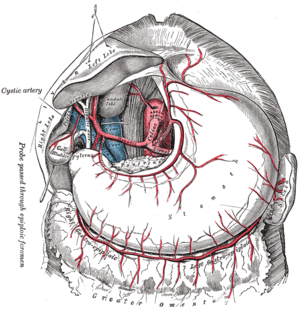 The coeliac artery and its branches. (Coeliac artery visible at center.) | |
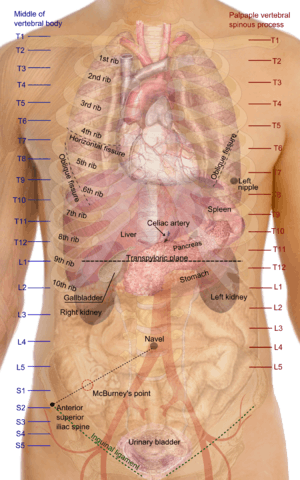 Surface projections of the major organs of the trunk, showing celiac artery in middle | |
| Details | |
| Precursor | vitelline arteries |
| Source | abdominal aorta |
| Branches | left gastric artery common hepatic artery splenic artery |
| Identifiers | |
| Latin | Truncus coeliacus, arteria coeliaca |
| MeSH | D002445 |
| TA | A12.2.12.012 |
| FMA | 50737 |
| Anatomical terminology | |
Structure
There are three main divisions of the celiac artery, and each in turn has its own named branches:
| Artery | Branches |
| left gastric artery | esophageal branch, stomach branch |
| common hepatic artery | proper hepatic artery, right gastric artery, gastroduodenal artery |
| splenic artery | dorsal pancreatic artery, short gastric arteries, left gastro-omental artery, greater pancreatic artery |
The celiac artery may also give rise to the inferior phrenic arteries.
Function
The celiac artery supplies oxygenated blood to the liver, stomach, abdominal esophagus, spleen and the superior half of both the duodenum and the pancreas. These structures correspond to the embryonic foregut. (Similarly, the superior mesenteric artery and inferior mesenteric artery feed structures arising from the embryonic midgut and hindgut respectively. Note that these three anterior branches of the abdominal aorta are distinct and cannot substitute for one another, although there are limited connections between their terminal branches.)
The celiac artery is an essential source of blood, since the interconnections with the other major arteries of the gut are not sufficient to sustain adequate perfusion. Thus it cannot be safely ligated in a living person, and obstruction of the celiac artery will lead to necrosis of the structures it supplies.
Drainage
The celiac artery is the only major artery that nourishes the abdominal digestive organs that does not have a similarly named vein.
Most blood returning from the digestive organs (including from the area of distribution of the celiac artery) is diverted to the liver via the portal venous system for further processing and detoxification in the liver before returning to the systemic circulation via the hepatic veins.
In contrast to the drainage of midgut and hindgut structures by the superior mesenteric vein and inferior mesenteric vein respectively, venous return from the coeliac artery is through either the splenic vein emptying into the hepatic portal vein or via smaller tributaries of the portal venous system.
Additional images
.gif) Animated Volume rendered CT scan of abdominal and pelvic blood vessels.
Animated Volume rendered CT scan of abdominal and pelvic blood vessels.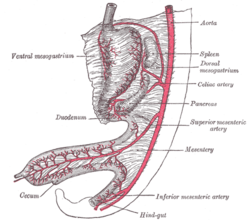 Abdominal part of digestive tube and its attachment to the primitive or common mesentery. Human embryo of six weeks.
Abdominal part of digestive tube and its attachment to the primitive or common mesentery. Human embryo of six weeks.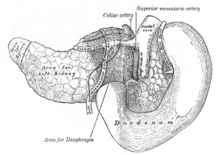 The pancreas and duodenum from behind.
The pancreas and duodenum from behind.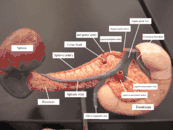 Arteries and veins around the pancreas and spleen.
Arteries and veins around the pancreas and spleen.
See also
External links
| Wikimedia Commons has media related to Human celiac artery. |
- Anatomy figure: 38:01-09 at Human Anatomy Online, SUNY Downstate Medical Center - "Branches of the celiac trunk."
- Anatomy figure: 40:05-01 at Human Anatomy Online, SUNY Downstate Medical Center - "Parietal and visceral branches of the abdominal aorta."
- celiactrunk at The Anatomy Lesson by Wesley Norman (Georgetown University)
- MedEd at Loyola Radio/curriculum/Vascular/hema144A.jpg